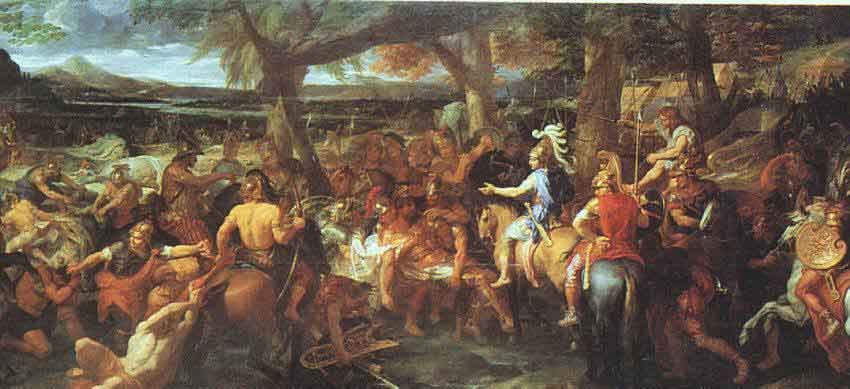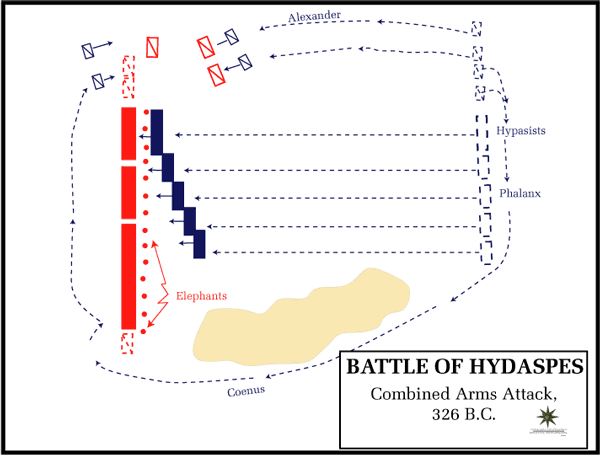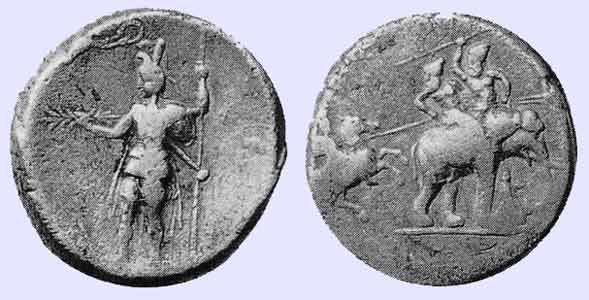.

Alexander and Porus by Charles Le Brun, 1673
The Battle of the Hydaspes River was a battle fought by Alexander the Great in 326 BC against the Indian king Purushotthama (better known as Porus) on the Hydaspes River (now the Jhelum) in present-day Pakistan. Although Alexander was victorious, his army refused to go any further into India. His tired army saw the use of elephants for the first time in war and were afraid of what other such war techniques might they have to face. Later Purushotthama trained Alexander's army to combat such attacks.
Combatants
Macedonians and various Greek, Persian and Indian Allies, led by Alexander. With about 4,000 cavalry and 50,000 infantry.
King Purushotthama with 200 War elephants, 6,000 Cavalry, and 30,000 Infantry.
The Macedonians also had a significant force (some say 5 times the amount Alexander commanded). Under the control of Craterus, they posed as a diversionary force across the river (see below).
Location
The battle took place on the east bank of the Hydaspes River, near present day Lilla, Pakistan and Bhora, Pakistan.
Prelude
After Alexander's defeat of the last remnants of the Achaemenidian Empire under Bessus in 328 BC, he started a new campaign versus the various Indian kings in 327 BC. Some place the invasion force as 120,000 men, others say that the fighting force was probably no more than 35,000 men, at most a third of it as cavalry.
The main train went into modern day Pakistan through the Khyber Pass, but a smaller force under the personal command of Alexander went through the northern route, taking a Fortress at Aornos (modern day Pir-Sar, Pakistan) on the way. In the early spring of next year, he combined his forces and allied with the King of Taxila against his neighbor the King of Hydaspes.
Battle

Alexander's Crossing of the River, 326 B.C.

Combined Arms Attack
The King of Hydaspes drew up on the left bank of the Hydaspes River, and was set to repel any crossings. The Hydaspes is deep and fast enough that any opposed crossing would probably doom the entire attacking force. So Alexander waited for several days, with lots of marches and counter-marches and information warfare (letting the local peasants "know" that he considered the water too high for crossing, which was learned of by Porus.) One night, after the Indians had gotten complacent, Alexander crossed the Hydaspes with a small force 17 miles upstream. The Porus, seeing the main body under the command of Craterus still in front of him, did not believe that it was a significant crossing, and sent only a small cavalry force under his son to oppose it. The force was easily routed, and Porus' son was killed.
When the battle actually started, the Alexandrian cavalry was to the right of their line, but Alexander sent a group of cavalry to circle behind the Indians and attack them from behind. The Indians were poised with cavalry on both flanks, the war elephants in front, and infantry behind the elephants.
These war elephants presented an especially difficult situation for Alexander. Most of his success on the battlefield has been due to his ability to seperate the enemy lines and drive his crack Companion Cavalry into the opening. This was used with devastating effectiveness at both Chaeronea and Gaugemala. However, the Indian elephants scared the Macedonian horses. The mere scent of these incredible creatures forced Alexander to modify his strategy.
Alexander started the battle with a customary charge on the right flank (the Indian's left) with predictable results, the Indian left became weak, and Porus reinforced that side with cavalry from the right. This left nobody to oppose the circling cavalry that attacked the Indian cavalry from behind. This was exactly what Alexander wanted. He was able to destroy the Indian cavalry without bringing his mounted units near the elephants. Had the Indian cavalry not been destroyed they would have endangered his phalanges later in the battle. The Macedonian horse would not have been able to support the foot soldiers against the Indian cavalry due to the proximity of the elephants.
Meanwhile, the Macedonian phalanges and the attached Persian infantry had advanced to engage the charge of the war elephants, which was stopped, albeit with heavy casualties to the infantry. The mahouts of the elephants were killed, and some hamstrung, the Alexandrian force eventually surrounded the Indian force. After massive casualties, Porus, who was wounded in the fighting, surrendered.
Casualty figures are hard to come by, but the Indians are said to have lost all of their cavalry, many (most?) of their infantry, and over 100 war elephants. The Alexandrians captured over 80 elephants, and suffered a heavy toll in their infantry. The losses to their cavalry arm was much less by comparison. Historian Peter Green argues that Alexander lost as many as 4,000 men, mostly phalanx troops. They had borne the brunt of the fighting against the elephants, as the horses of the Macedonian cavalry had refused to go near the beasts.

Alexander the Great and Porus after the Battle.
Aftermath
|
Battle of the Hydaspes River |
||
|---|---|---|
|
Conflict |
Wars of Alexander the Great |
|
|
Date |
326 BC |
|
|
Place |
Near the Hydaspes River |
|
|
Result |
Macedonian victory |
|
|
Combatants |
||
|
Macedon |
India |
|
|
Commanders |
||
|
Alexander the Great |
Purushotthama |
|
|
Strength |
||
|
4000 cavalry |
6000 cavalry |
|
|
Casualties |
||
|
Many infantry |
All cavalry |
|
Despite the defeat, Alexander spared Porus' life and let him rule Hydaspes in Alexander's name. This was the furthest that Alexander went, as his army refused to go any further after seeing the first real use of the war elephants and hearing rumors of other more exotic weapons in store in the Indian heartlands.
Curiously, this was not the first time that either the Persians or the Macedonians saw war elephants. There were 20 in Darius's army at the Battle of Gaugamela but they appeared not to have much impact on the battle. Hydaspes River might have been the first time they saw an elephant charge. The combat against these attacking pachyderms was said to have had a fearful psychological effect on Alexander's men, particularly those in the phalanges. The situation was comparable to infantry fighting tanks, and Alexander's men could arguably have suffered from the ancient equivalent of "tank fright". That they withstood the war elephants was a tremendous testament to their discipline and skill as soldiers.
Alexander died a few years later in 323 BC and his empire fell apart to civil war. After various battles and revolts, Hydaspes again became independent. As a result of this battle, Alexander founded two cities, Nicaea (Victory) at the site of modern day Jalapur, Pakistan and Bucephala at the site (possibly) of Bhora. Bucephalus was the name of the horse that Alexander rode on, having died either during battle or right afterwards of weariness and old age.

Coin commemorating Alexander's campaigns in India, struck in Babylon around 323 BC.
Obv: Alexander standing, being crowned by Nike, fully armed and holding Zeus' thunderbolt.
Rev: Greek rider, possibly Alexander, attacking an Indian battle-elephant, possibly during the battle against Porus.

Alexander and Porus
Battle Maps : http://www.dean.usma.edu
| Ancient Greece
Science, Technology , Medicine , Warfare, , Biographies , Life , Cities/Places/Maps , Arts , Literature , Philosophy ,Olympics, Mythology , History , Images Medieval Greece / Byzantine Empire Science, Technology, Arts, , Warfare , Literature, Biographies, Icons, History Modern Greece Cities, Islands, Regions, Fauna/Flora ,Biographies , History , Warfare, Science/Technology, Literature, Music , Arts , Film/Actors , Sport , Fashion --- |
Retrieved from "http://en.wikipedia.org"
All text is available under the terms of the GNU Free Documentation License

